Safety and Risk Management: A Case Study of the Granville Disaster
VerifiedAdded on 2023/06/08
|10
|2194
|60
Report
AI Summary
This report analyzes the 1977 Granville train disaster in New South Wales, Australia, focusing on the safety breaches that contributed to the incident. The report discusses the derailment of a commuter train, which led to the collapse of a road bridge, resulting in 84 deaths and 213 injuries. It examines factors such as the failure to maintain fasteners on the tracks and the dangerous placement of gas cylinders. The report also highlights the government's initial lack of support for railway safety and the subsequent changes to policy and practice, including the formation of the Granville Train Disaster Association Inc. Recommendations are provided, including increased budget allocation for railway maintenance, the involvement of trained personnel for track management, and the establishment of a disaster management team to improve crisis response and prevent future incidents. The report concludes that prioritizing safety and implementing necessary changes are crucial for preventing similar disasters and ensuring public safety.
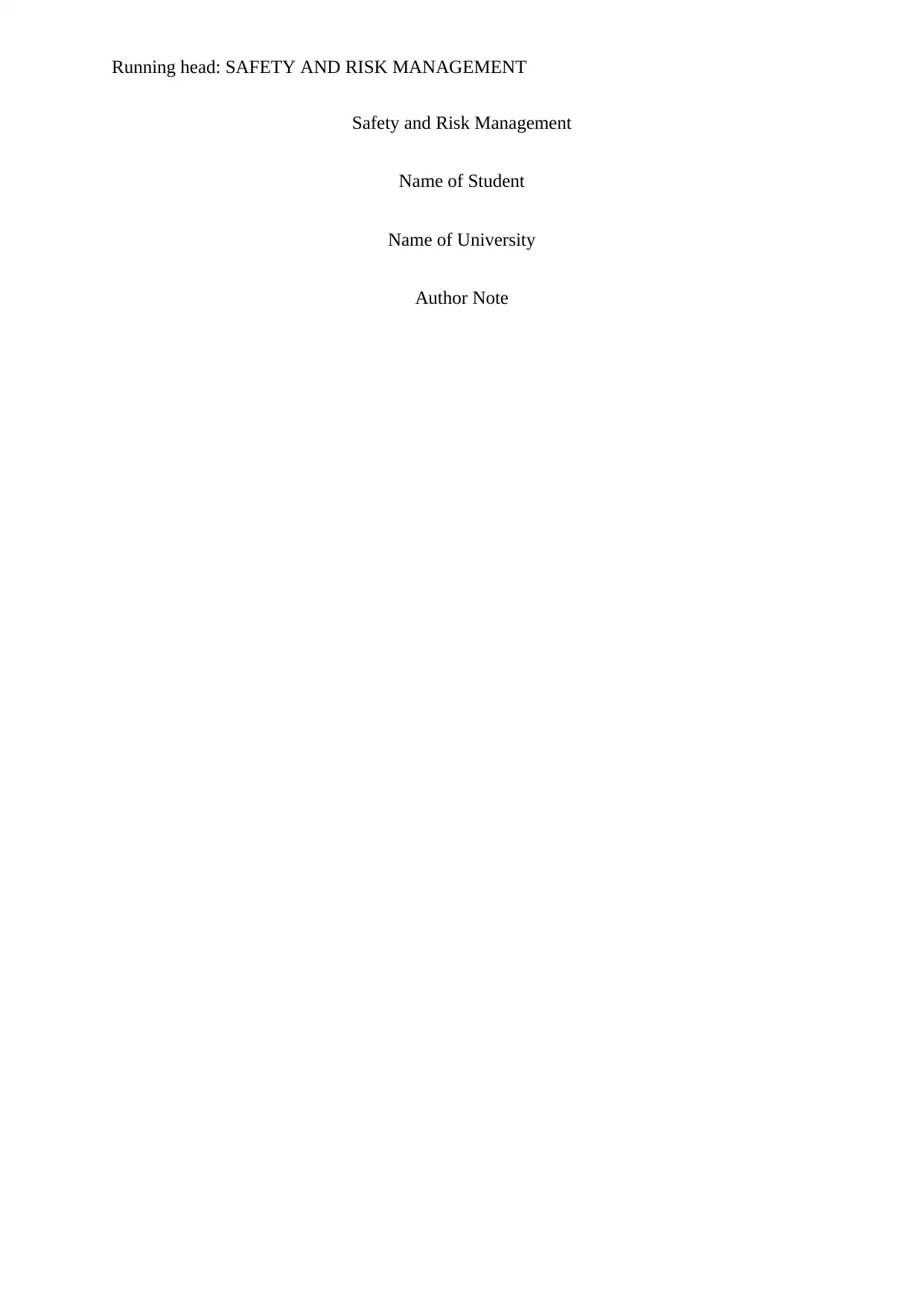
Running head: SAFETY AND RISK MANAGEMENT
Safety and Risk Management
Name of Student
Name of University
Author Note
Safety and Risk Management
Name of Student
Name of University
Author Note
Paraphrase This Document
Need a fresh take? Get an instant paraphrase of this document with our AI Paraphraser

1
SAFETY AND RISK MANAGEMENT
Table of Contents
Introduction................................................................................................................................3
Discussion..................................................................................................................................3
Recommendation........................................................................................................................5
Conclusion..................................................................................................................................6
Bibliography...............................................................................................................................8
SAFETY AND RISK MANAGEMENT
Table of Contents
Introduction................................................................................................................................3
Discussion..................................................................................................................................3
Recommendation........................................................................................................................5
Conclusion..................................................................................................................................6
Bibliography...............................................................................................................................8
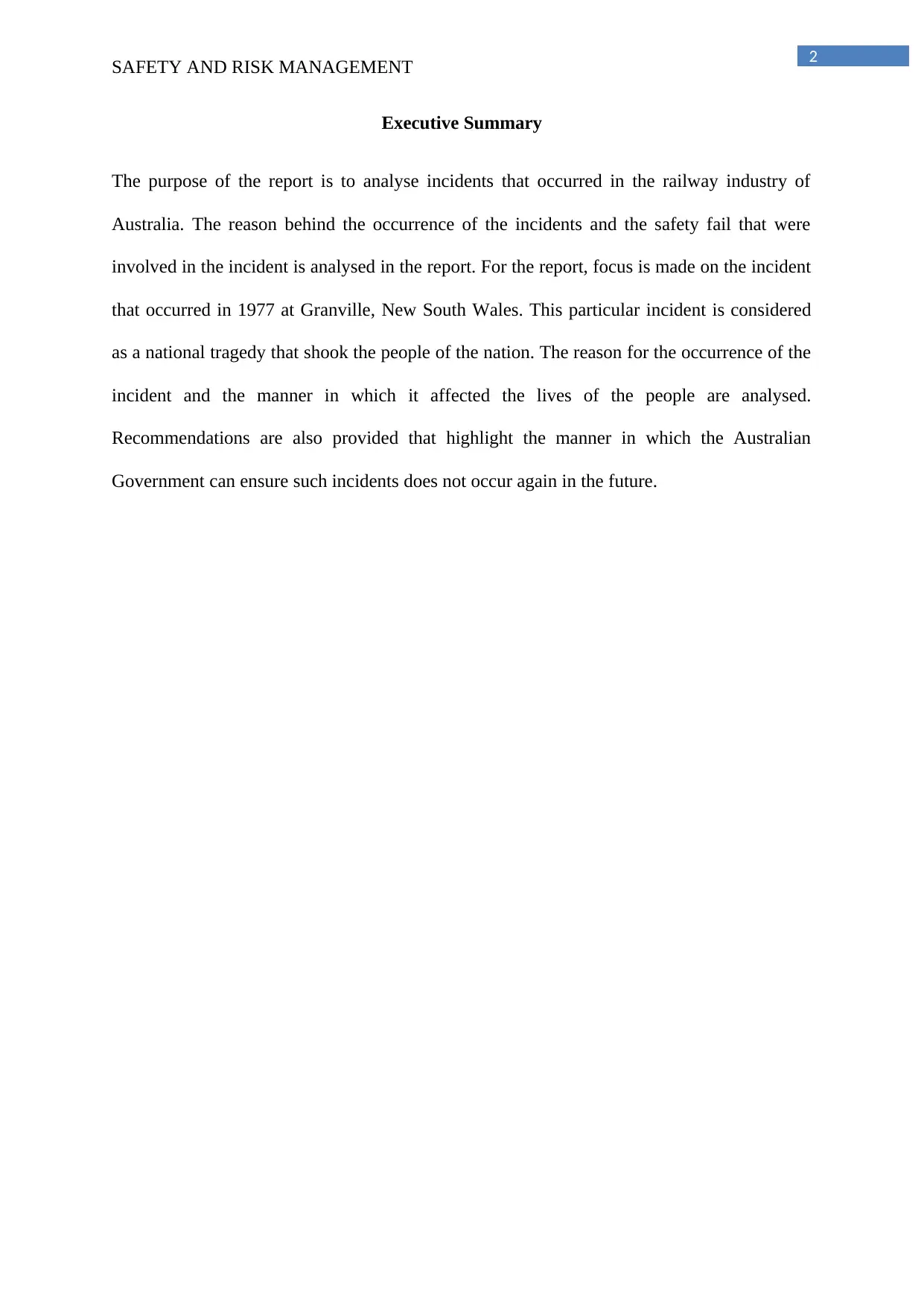
2
SAFETY AND RISK MANAGEMENT
Executive Summary
The purpose of the report is to analyse incidents that occurred in the railway industry of
Australia. The reason behind the occurrence of the incidents and the safety fail that were
involved in the incident is analysed in the report. For the report, focus is made on the incident
that occurred in 1977 at Granville, New South Wales. This particular incident is considered
as a national tragedy that shook the people of the nation. The reason for the occurrence of the
incident and the manner in which it affected the lives of the people are analysed.
Recommendations are also provided that highlight the manner in which the Australian
Government can ensure such incidents does not occur again in the future.
SAFETY AND RISK MANAGEMENT
Executive Summary
The purpose of the report is to analyse incidents that occurred in the railway industry of
Australia. The reason behind the occurrence of the incidents and the safety fail that were
involved in the incident is analysed in the report. For the report, focus is made on the incident
that occurred in 1977 at Granville, New South Wales. This particular incident is considered
as a national tragedy that shook the people of the nation. The reason for the occurrence of the
incident and the manner in which it affected the lives of the people are analysed.
Recommendations are also provided that highlight the manner in which the Australian
Government can ensure such incidents does not occur again in the future.
⊘ This is a preview!⊘
Do you want full access?
Subscribe today to unlock all pages.

Trusted by 1+ million students worldwide
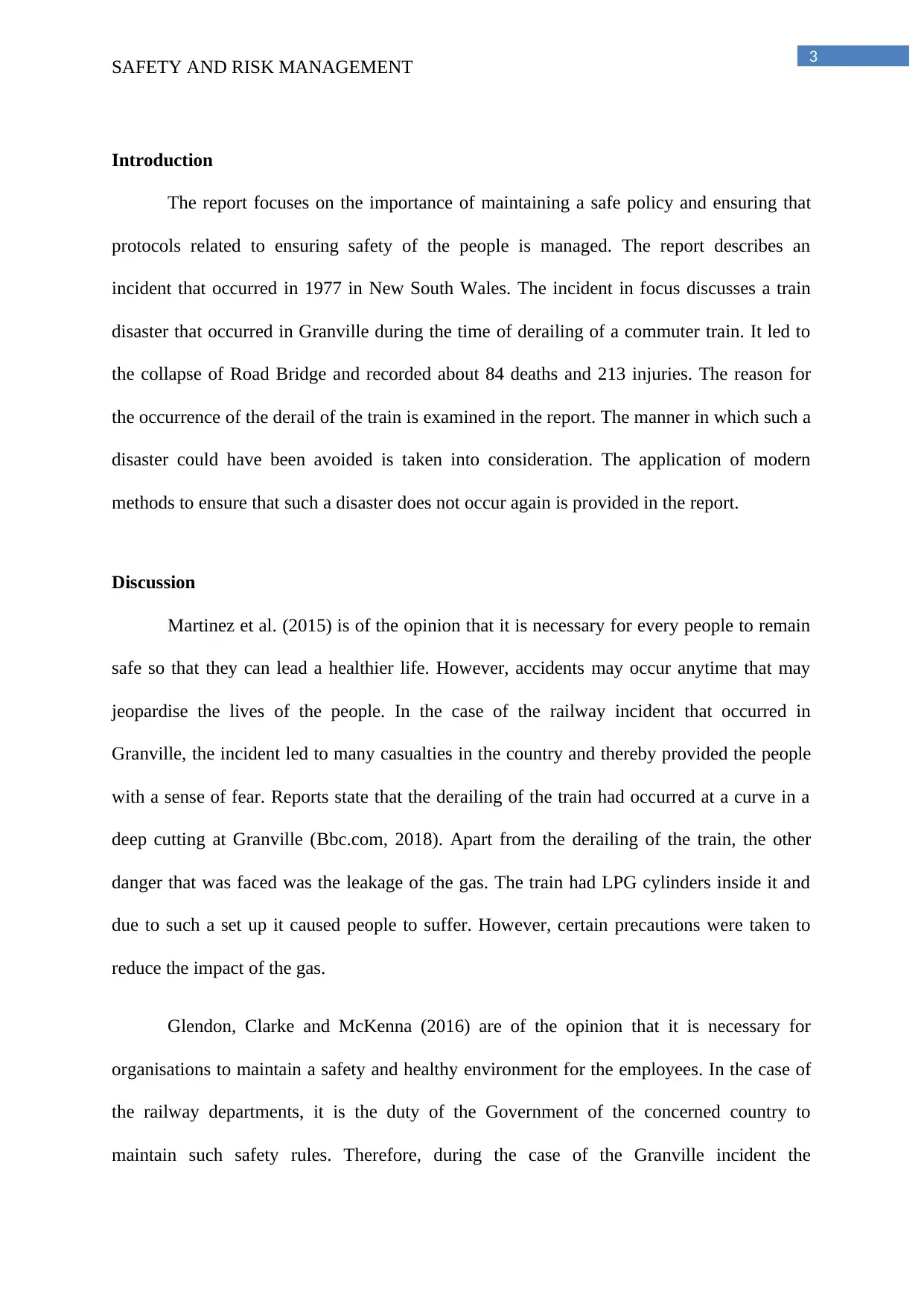
3
SAFETY AND RISK MANAGEMENT
Introduction
The report focuses on the importance of maintaining a safe policy and ensuring that
protocols related to ensuring safety of the people is managed. The report describes an
incident that occurred in 1977 in New South Wales. The incident in focus discusses a train
disaster that occurred in Granville during the time of derailing of a commuter train. It led to
the collapse of Road Bridge and recorded about 84 deaths and 213 injuries. The reason for
the occurrence of the derail of the train is examined in the report. The manner in which such a
disaster could have been avoided is taken into consideration. The application of modern
methods to ensure that such a disaster does not occur again is provided in the report.
Discussion
Martinez et al. (2015) is of the opinion that it is necessary for every people to remain
safe so that they can lead a healthier life. However, accidents may occur anytime that may
jeopardise the lives of the people. In the case of the railway incident that occurred in
Granville, the incident led to many casualties in the country and thereby provided the people
with a sense of fear. Reports state that the derailing of the train had occurred at a curve in a
deep cutting at Granville (Bbc.com, 2018). Apart from the derailing of the train, the other
danger that was faced was the leakage of the gas. The train had LPG cylinders inside it and
due to such a set up it caused people to suffer. However, certain precautions were taken to
reduce the impact of the gas.
Glendon, Clarke and McKenna (2016) are of the opinion that it is necessary for
organisations to maintain a safety and healthy environment for the employees. In the case of
the railway departments, it is the duty of the Government of the concerned country to
maintain such safety rules. Therefore, during the case of the Granville incident the
SAFETY AND RISK MANAGEMENT
Introduction
The report focuses on the importance of maintaining a safe policy and ensuring that
protocols related to ensuring safety of the people is managed. The report describes an
incident that occurred in 1977 in New South Wales. The incident in focus discusses a train
disaster that occurred in Granville during the time of derailing of a commuter train. It led to
the collapse of Road Bridge and recorded about 84 deaths and 213 injuries. The reason for
the occurrence of the derail of the train is examined in the report. The manner in which such a
disaster could have been avoided is taken into consideration. The application of modern
methods to ensure that such a disaster does not occur again is provided in the report.
Discussion
Martinez et al. (2015) is of the opinion that it is necessary for every people to remain
safe so that they can lead a healthier life. However, accidents may occur anytime that may
jeopardise the lives of the people. In the case of the railway incident that occurred in
Granville, the incident led to many casualties in the country and thereby provided the people
with a sense of fear. Reports state that the derailing of the train had occurred at a curve in a
deep cutting at Granville (Bbc.com, 2018). Apart from the derailing of the train, the other
danger that was faced was the leakage of the gas. The train had LPG cylinders inside it and
due to such a set up it caused people to suffer. However, certain precautions were taken to
reduce the impact of the gas.
Glendon, Clarke and McKenna (2016) are of the opinion that it is necessary for
organisations to maintain a safety and healthy environment for the employees. In the case of
the railway departments, it is the duty of the Government of the concerned country to
maintain such safety rules. Therefore, during the case of the Granville incident the
Paraphrase This Document
Need a fresh take? Get an instant paraphrase of this document with our AI Paraphraser
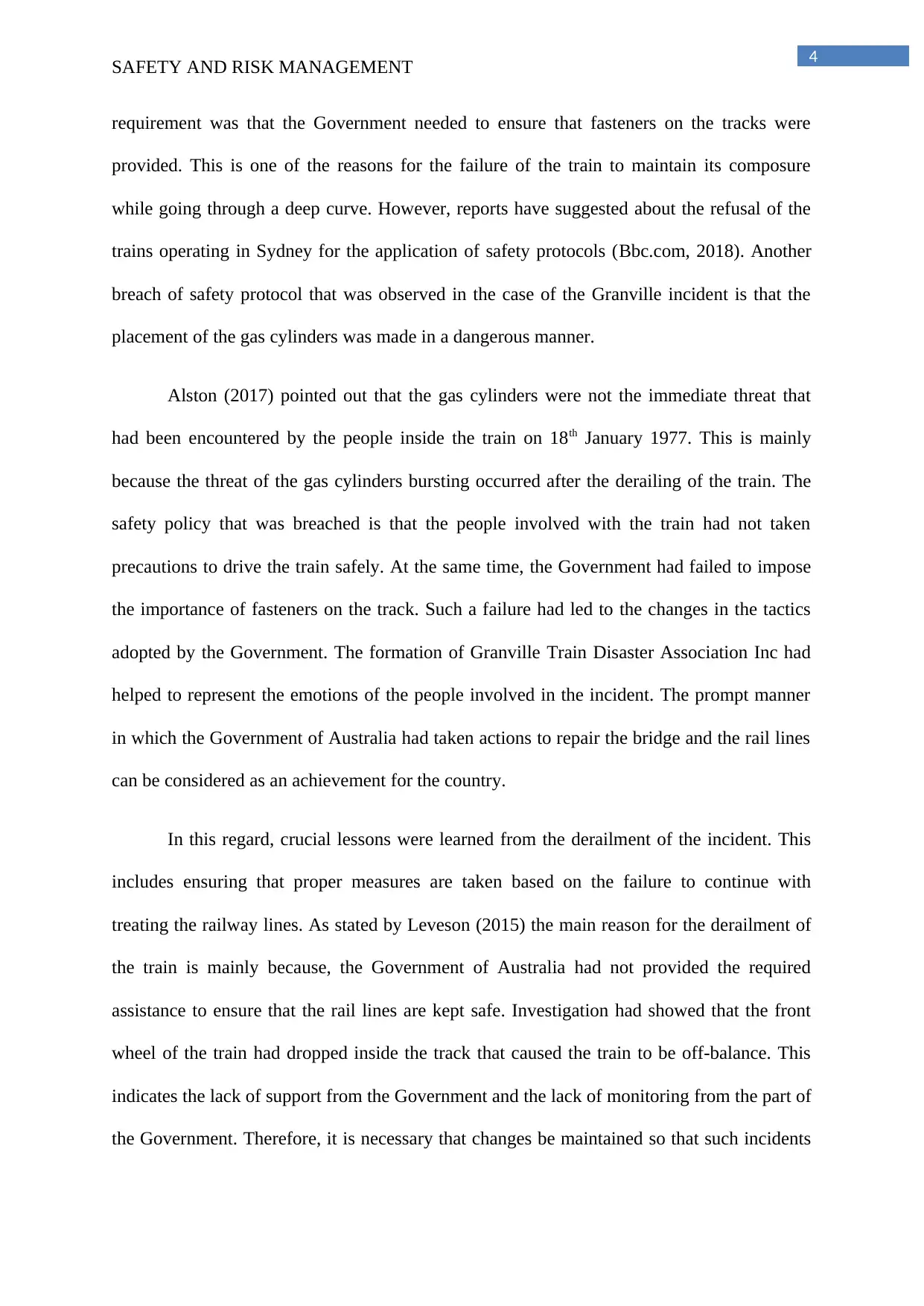
4
SAFETY AND RISK MANAGEMENT
requirement was that the Government needed to ensure that fasteners on the tracks were
provided. This is one of the reasons for the failure of the train to maintain its composure
while going through a deep curve. However, reports have suggested about the refusal of the
trains operating in Sydney for the application of safety protocols (Bbc.com, 2018). Another
breach of safety protocol that was observed in the case of the Granville incident is that the
placement of the gas cylinders was made in a dangerous manner.
Alston (2017) pointed out that the gas cylinders were not the immediate threat that
had been encountered by the people inside the train on 18th January 1977. This is mainly
because the threat of the gas cylinders bursting occurred after the derailing of the train. The
safety policy that was breached is that the people involved with the train had not taken
precautions to drive the train safely. At the same time, the Government had failed to impose
the importance of fasteners on the track. Such a failure had led to the changes in the tactics
adopted by the Government. The formation of Granville Train Disaster Association Inc had
helped to represent the emotions of the people involved in the incident. The prompt manner
in which the Government of Australia had taken actions to repair the bridge and the rail lines
can be considered as an achievement for the country.
In this regard, crucial lessons were learned from the derailment of the incident. This
includes ensuring that proper measures are taken based on the failure to continue with
treating the railway lines. As stated by Leveson (2015) the main reason for the derailment of
the train is mainly because, the Government of Australia had not provided the required
assistance to ensure that the rail lines are kept safe. Investigation had showed that the front
wheel of the train had dropped inside the track that caused the train to be off-balance. This
indicates the lack of support from the Government and the lack of monitoring from the part of
the Government. Therefore, it is necessary that changes be maintained so that such incidents
SAFETY AND RISK MANAGEMENT
requirement was that the Government needed to ensure that fasteners on the tracks were
provided. This is one of the reasons for the failure of the train to maintain its composure
while going through a deep curve. However, reports have suggested about the refusal of the
trains operating in Sydney for the application of safety protocols (Bbc.com, 2018). Another
breach of safety protocol that was observed in the case of the Granville incident is that the
placement of the gas cylinders was made in a dangerous manner.
Alston (2017) pointed out that the gas cylinders were not the immediate threat that
had been encountered by the people inside the train on 18th January 1977. This is mainly
because the threat of the gas cylinders bursting occurred after the derailing of the train. The
safety policy that was breached is that the people involved with the train had not taken
precautions to drive the train safely. At the same time, the Government had failed to impose
the importance of fasteners on the track. Such a failure had led to the changes in the tactics
adopted by the Government. The formation of Granville Train Disaster Association Inc had
helped to represent the emotions of the people involved in the incident. The prompt manner
in which the Government of Australia had taken actions to repair the bridge and the rail lines
can be considered as an achievement for the country.
In this regard, crucial lessons were learned from the derailment of the incident. This
includes ensuring that proper measures are taken based on the failure to continue with
treating the railway lines. As stated by Leveson (2015) the main reason for the derailment of
the train is mainly because, the Government of Australia had not provided the required
assistance to ensure that the rail lines are kept safe. Investigation had showed that the front
wheel of the train had dropped inside the track that caused the train to be off-balance. This
indicates the lack of support from the Government and the lack of monitoring from the part of
the Government. Therefore, it is necessary that changes be maintained so that such incidents

5
SAFETY AND RISK MANAGEMENT
does not occur again and that the people of Australia can be provided with the required level
of safety for commencing their journey via rail road.
At the same, time, as stated by Aven (2016) the aftermath had the bridge be rebuild
within a single span so that intermediate support can be provided. The damages that had been
done needed to be repaired keeping in mind the cost that is required. The duty of the
Government regarding the damage had not been fulfilled and it is for this reason that the
Government of the country need to undertake responsibility for the proper commencement of
the building of the bridge and for the repair of its damages. According to Boyle (2015), the
health and safety of the people need to be the top most priority and it is necessary that proper
actions are taken that can help in preventing such disasters in the future.
The changes towards the policy adopted by the safety department of Australia indicate
that it is necessary for the people as well as the Government to take precautions regarding the
safety of the public. As stated by Sadgrove (2016) it is important for every people to
understand the importance of safety and spread awareness about its importance. It is
necessary that the Government as well as the people maintain necessary collaboration for the
safety of the people. At the same time, changes regarding the re-building of the bridges and
the railway track were commenced so that the daily life of the people can be made to
continue. Faulty wheel was also the reason for the derailment of the train as it failed to
capitalise on the brakes during the time of need. Hence, it can be said that recommendations
can be provided that can help in fixing the problem in the future.
Recommendation
The aftermath of the incident had led the Government of Australia to take actions
regarding the welfare of the people. The changes brought about have provided the railway
companies with an opportunity to ensure that the passengers remain safe. One of the biggest
SAFETY AND RISK MANAGEMENT
does not occur again and that the people of Australia can be provided with the required level
of safety for commencing their journey via rail road.
At the same, time, as stated by Aven (2016) the aftermath had the bridge be rebuild
within a single span so that intermediate support can be provided. The damages that had been
done needed to be repaired keeping in mind the cost that is required. The duty of the
Government regarding the damage had not been fulfilled and it is for this reason that the
Government of the country need to undertake responsibility for the proper commencement of
the building of the bridge and for the repair of its damages. According to Boyle (2015), the
health and safety of the people need to be the top most priority and it is necessary that proper
actions are taken that can help in preventing such disasters in the future.
The changes towards the policy adopted by the safety department of Australia indicate
that it is necessary for the people as well as the Government to take precautions regarding the
safety of the public. As stated by Sadgrove (2016) it is important for every people to
understand the importance of safety and spread awareness about its importance. It is
necessary that the Government as well as the people maintain necessary collaboration for the
safety of the people. At the same time, changes regarding the re-building of the bridges and
the railway track were commenced so that the daily life of the people can be made to
continue. Faulty wheel was also the reason for the derailment of the train as it failed to
capitalise on the brakes during the time of need. Hence, it can be said that recommendations
can be provided that can help in fixing the problem in the future.
Recommendation
The aftermath of the incident had led the Government of Australia to take actions
regarding the welfare of the people. The changes brought about have provided the railway
companies with an opportunity to ensure that the passengers remain safe. One of the biggest
⊘ This is a preview!⊘
Do you want full access?
Subscribe today to unlock all pages.

Trusted by 1+ million students worldwide
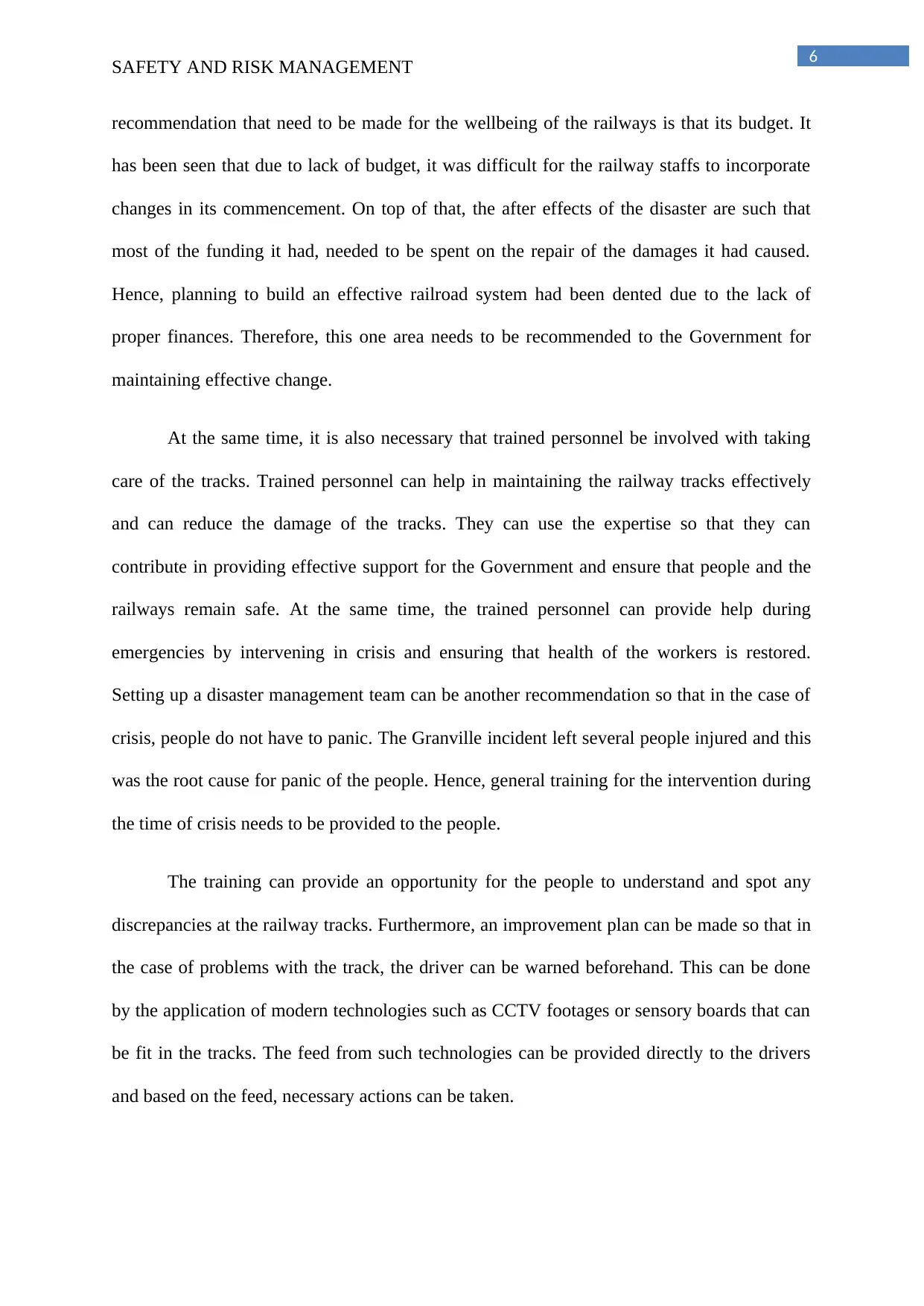
6
SAFETY AND RISK MANAGEMENT
recommendation that need to be made for the wellbeing of the railways is that its budget. It
has been seen that due to lack of budget, it was difficult for the railway staffs to incorporate
changes in its commencement. On top of that, the after effects of the disaster are such that
most of the funding it had, needed to be spent on the repair of the damages it had caused.
Hence, planning to build an effective railroad system had been dented due to the lack of
proper finances. Therefore, this one area needs to be recommended to the Government for
maintaining effective change.
At the same time, it is also necessary that trained personnel be involved with taking
care of the tracks. Trained personnel can help in maintaining the railway tracks effectively
and can reduce the damage of the tracks. They can use the expertise so that they can
contribute in providing effective support for the Government and ensure that people and the
railways remain safe. At the same time, the trained personnel can provide help during
emergencies by intervening in crisis and ensuring that health of the workers is restored.
Setting up a disaster management team can be another recommendation so that in the case of
crisis, people do not have to panic. The Granville incident left several people injured and this
was the root cause for panic of the people. Hence, general training for the intervention during
the time of crisis needs to be provided to the people.
The training can provide an opportunity for the people to understand and spot any
discrepancies at the railway tracks. Furthermore, an improvement plan can be made so that in
the case of problems with the track, the driver can be warned beforehand. This can be done
by the application of modern technologies such as CCTV footages or sensory boards that can
be fit in the tracks. The feed from such technologies can be provided directly to the drivers
and based on the feed, necessary actions can be taken.
SAFETY AND RISK MANAGEMENT
recommendation that need to be made for the wellbeing of the railways is that its budget. It
has been seen that due to lack of budget, it was difficult for the railway staffs to incorporate
changes in its commencement. On top of that, the after effects of the disaster are such that
most of the funding it had, needed to be spent on the repair of the damages it had caused.
Hence, planning to build an effective railroad system had been dented due to the lack of
proper finances. Therefore, this one area needs to be recommended to the Government for
maintaining effective change.
At the same time, it is also necessary that trained personnel be involved with taking
care of the tracks. Trained personnel can help in maintaining the railway tracks effectively
and can reduce the damage of the tracks. They can use the expertise so that they can
contribute in providing effective support for the Government and ensure that people and the
railways remain safe. At the same time, the trained personnel can provide help during
emergencies by intervening in crisis and ensuring that health of the workers is restored.
Setting up a disaster management team can be another recommendation so that in the case of
crisis, people do not have to panic. The Granville incident left several people injured and this
was the root cause for panic of the people. Hence, general training for the intervention during
the time of crisis needs to be provided to the people.
The training can provide an opportunity for the people to understand and spot any
discrepancies at the railway tracks. Furthermore, an improvement plan can be made so that in
the case of problems with the track, the driver can be warned beforehand. This can be done
by the application of modern technologies such as CCTV footages or sensory boards that can
be fit in the tracks. The feed from such technologies can be provided directly to the drivers
and based on the feed, necessary actions can be taken.
Paraphrase This Document
Need a fresh take? Get an instant paraphrase of this document with our AI Paraphraser
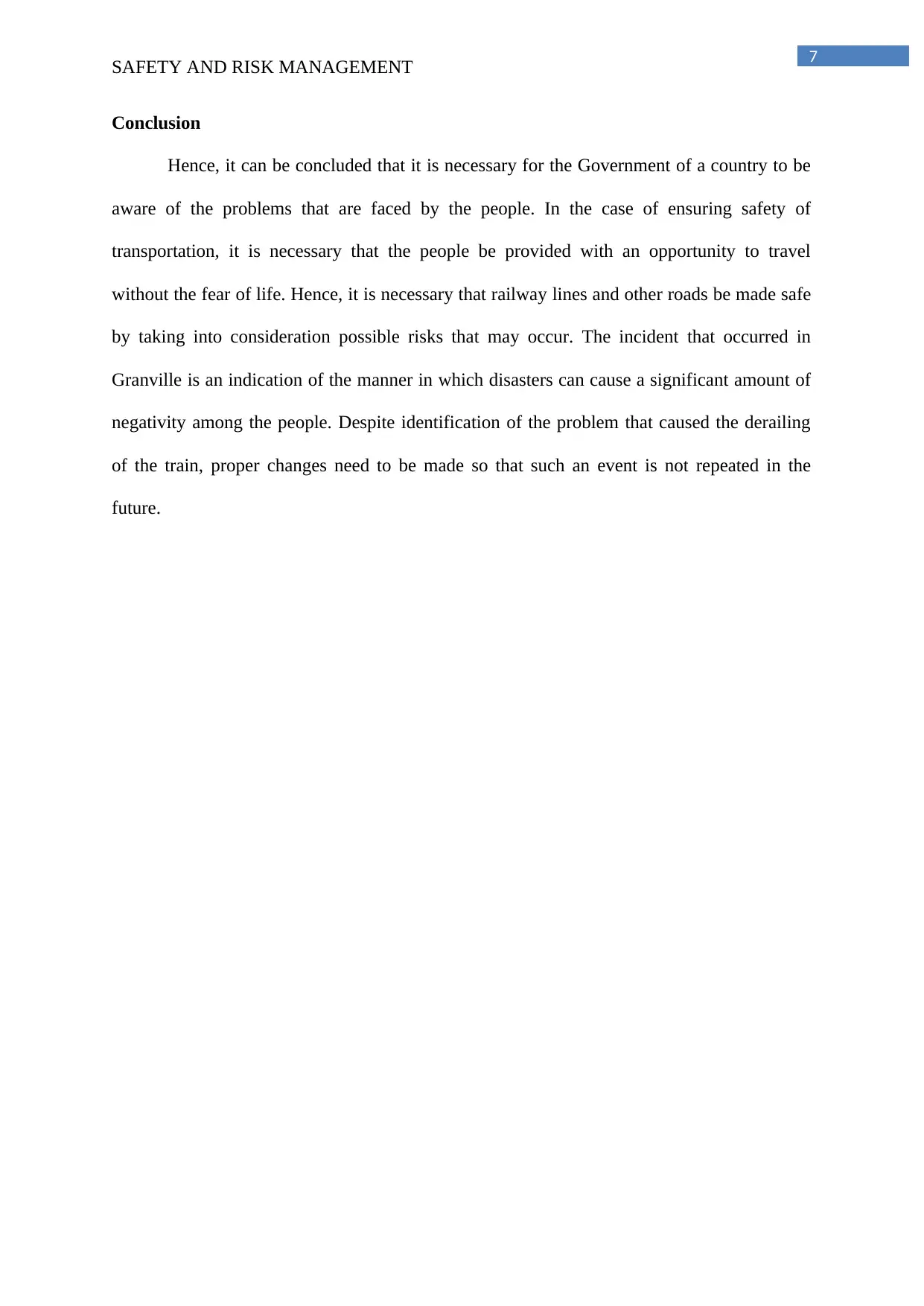
7
SAFETY AND RISK MANAGEMENT
Conclusion
Hence, it can be concluded that it is necessary for the Government of a country to be
aware of the problems that are faced by the people. In the case of ensuring safety of
transportation, it is necessary that the people be provided with an opportunity to travel
without the fear of life. Hence, it is necessary that railway lines and other roads be made safe
by taking into consideration possible risks that may occur. The incident that occurred in
Granville is an indication of the manner in which disasters can cause a significant amount of
negativity among the people. Despite identification of the problem that caused the derailing
of the train, proper changes need to be made so that such an event is not repeated in the
future.
SAFETY AND RISK MANAGEMENT
Conclusion
Hence, it can be concluded that it is necessary for the Government of a country to be
aware of the problems that are faced by the people. In the case of ensuring safety of
transportation, it is necessary that the people be provided with an opportunity to travel
without the fear of life. Hence, it is necessary that railway lines and other roads be made safe
by taking into consideration possible risks that may occur. The incident that occurred in
Granville is an indication of the manner in which disasters can cause a significant amount of
negativity among the people. Despite identification of the problem that caused the derailing
of the train, proper changes need to be made so that such an event is not repeated in the
future.

8
SAFETY AND RISK MANAGEMENT
Bibliography
Alston, G. (2017). How safe is safe enough?: Leadership, safety and risk management.
Routledge.
An, M., & Qin, Y. (2016). Challenges of Railway Safety Risk Assessment and Maintenance
Decision Making. In Handbook of Research on Emerging Innovations in Rail
Transportation Engineering (pp. 173-211). IGI Global.
Aven, T. (2016). Risk assessment and risk management: Review of recent advances on their
foundation. European Journal of Operational Research, 253(1), 1-13.
Bbc.com. (2018). Retrieved from https://www.bbc.com/news/world-australia-38645976
Boyle, T. (2015). Health and safety: risk management. Routledge.
Glendon, A. I., Clarke, S., & McKenna, E. (2016). Human safety and risk management. Crc
Press.
Khan, F., Hashemi, S. J., Paltrinieri, N., Amyotte, P., Cozzani, V., & Reniers, G. (2016).
Dynamic risk management: a contemporary approach to process safety
management. Current opinion in chemical engineering, 14, 9-17.
Leveson, N. (2015). A systems approach to risk management through leading safety
indicators. Reliability Engineering & System Safety, 136, 17-34.
Martinez, W., Etchegaray, J. M., Thomas, E. J., Hickson, G. B., Lehmann, L. S., Schleyer, A.
M., ... & Bell, S. K. (2015). ‘Speaking up’about patient safety concerns and
unprofessional behaviour among residents: validation of two scales. BMJ Qual Saf,
bmjqs-2015.
SAFETY AND RISK MANAGEMENT
Bibliography
Alston, G. (2017). How safe is safe enough?: Leadership, safety and risk management.
Routledge.
An, M., & Qin, Y. (2016). Challenges of Railway Safety Risk Assessment and Maintenance
Decision Making. In Handbook of Research on Emerging Innovations in Rail
Transportation Engineering (pp. 173-211). IGI Global.
Aven, T. (2016). Risk assessment and risk management: Review of recent advances on their
foundation. European Journal of Operational Research, 253(1), 1-13.
Bbc.com. (2018). Retrieved from https://www.bbc.com/news/world-australia-38645976
Boyle, T. (2015). Health and safety: risk management. Routledge.
Glendon, A. I., Clarke, S., & McKenna, E. (2016). Human safety and risk management. Crc
Press.
Khan, F., Hashemi, S. J., Paltrinieri, N., Amyotte, P., Cozzani, V., & Reniers, G. (2016).
Dynamic risk management: a contemporary approach to process safety
management. Current opinion in chemical engineering, 14, 9-17.
Leveson, N. (2015). A systems approach to risk management through leading safety
indicators. Reliability Engineering & System Safety, 136, 17-34.
Martinez, W., Etchegaray, J. M., Thomas, E. J., Hickson, G. B., Lehmann, L. S., Schleyer, A.
M., ... & Bell, S. K. (2015). ‘Speaking up’about patient safety concerns and
unprofessional behaviour among residents: validation of two scales. BMJ Qual Saf,
bmjqs-2015.
⊘ This is a preview!⊘
Do you want full access?
Subscribe today to unlock all pages.

Trusted by 1+ million students worldwide
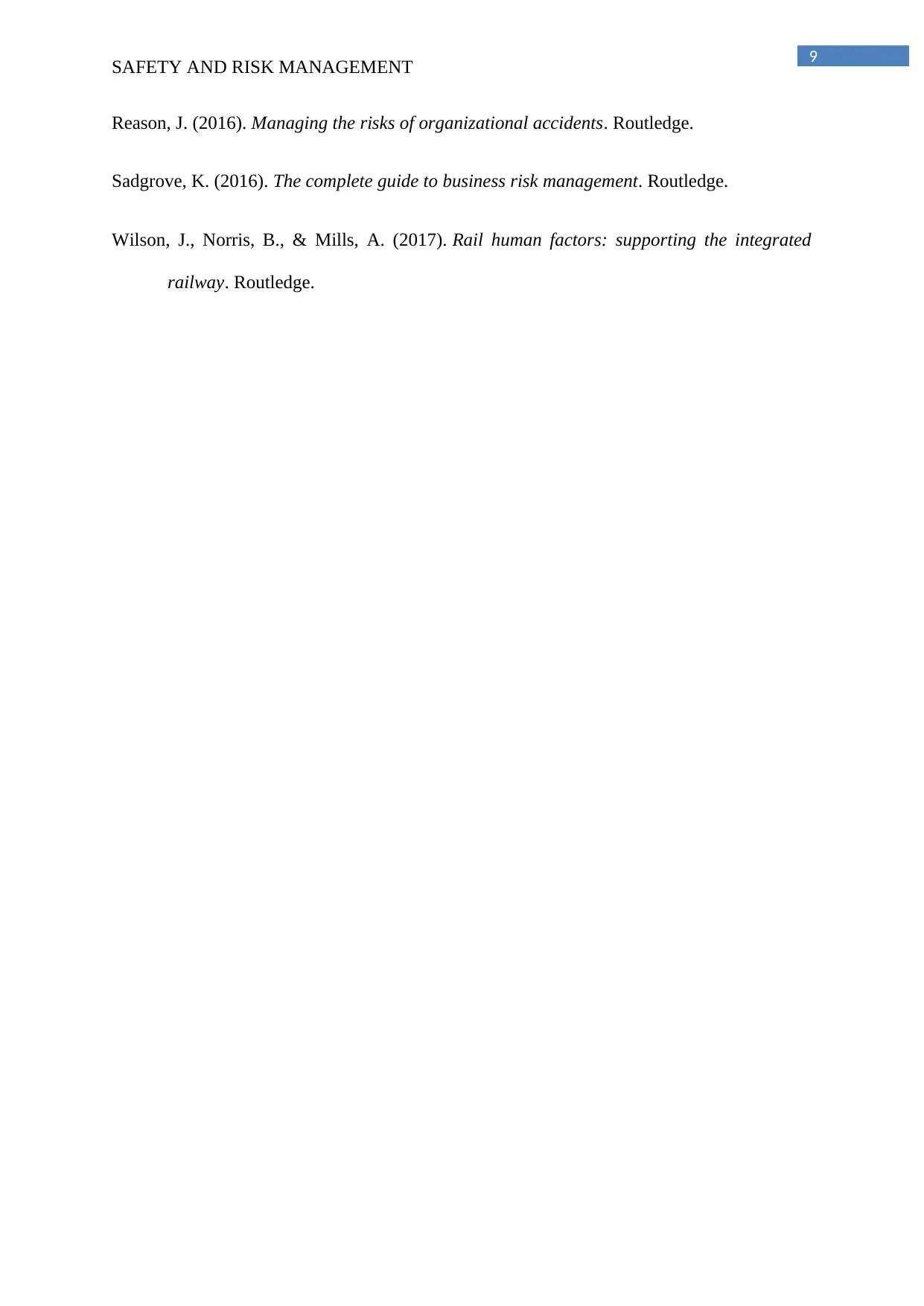
9
SAFETY AND RISK MANAGEMENT
Reason, J. (2016). Managing the risks of organizational accidents. Routledge.
Sadgrove, K. (2016). The complete guide to business risk management. Routledge.
Wilson, J., Norris, B., & Mills, A. (2017). Rail human factors: supporting the integrated
railway. Routledge.
SAFETY AND RISK MANAGEMENT
Reason, J. (2016). Managing the risks of organizational accidents. Routledge.
Sadgrove, K. (2016). The complete guide to business risk management. Routledge.
Wilson, J., Norris, B., & Mills, A. (2017). Rail human factors: supporting the integrated
railway. Routledge.
1 out of 10
Related Documents
Your All-in-One AI-Powered Toolkit for Academic Success.
+13062052269
info@desklib.com
Available 24*7 on WhatsApp / Email
![[object Object]](/_next/static/media/star-bottom.7253800d.svg)
Unlock your academic potential
Copyright © 2020–2025 A2Z Services. All Rights Reserved. Developed and managed by ZUCOL.





